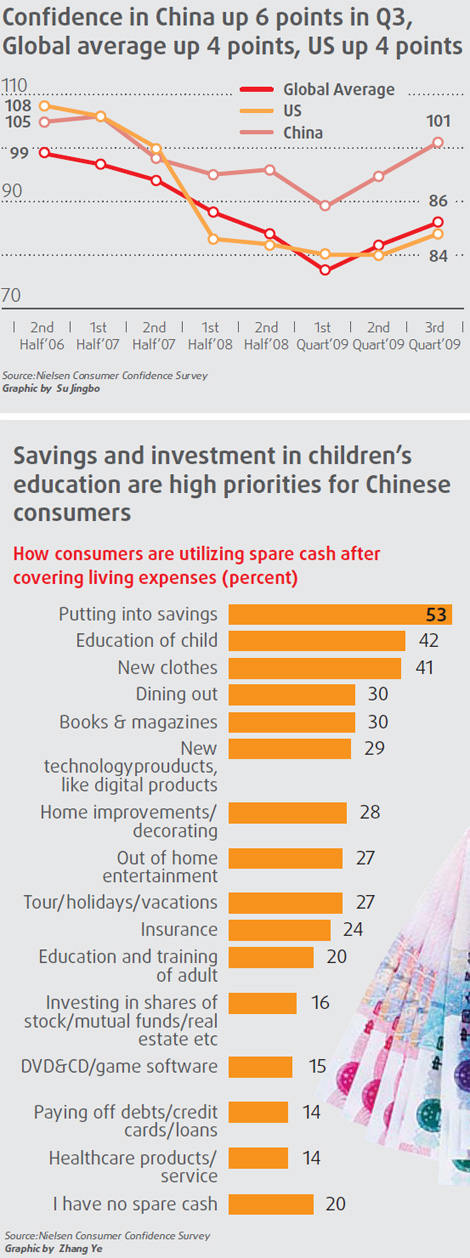
|
BIZCHINA> Insights
 |
|
Consumer spending on the rise in China
By Si Tingting (China Daily)
Updated: 2009-11-16 08:02 Urban demand Urban demand, meanwhile, is being boosted as millions move into the $4,000 to $6,000 income bracket in China and shift from spending only on essentials to buying more expensive goods such as apartments, cars and electronic appliances. The next 10 years will witness a boom in the number of small and medium-sized enterprises (SMEs), said Zhou Tianyong, deputy director of the Research Office of the Party School of the Communist Party of China Central Committee. Such a trend will bring more people up to the wealthier echelon, as SMEs tend to provide more job opportunities than capital-intensive State-owned companies. Since more residents of rural communities are moving to the cities, their spending patterns will be influenced by their fellow urban dwellers, he said. In the coming decade, Zhou said, people will continue spending to improve their living standards, and they will continue buying cars, electronic devices, healthcare products and beauty products. In addition, they will start consuming more service products provided by educational institutions, domestic workers, travel agents and the entertainment sector, he said. Therefore, economists and experts are arguing that China should try to keep migrant workers in the cities, as they will be the future spenders. Fan Jianping, a senior analyst at the State Information Center, suggested that China should issue certain residence policies to give migrant workers incentives to buy apartments and to include them in the social security safety net enjoyed by their counterparts born in cities. These efforts are needed to encourage migrant workers to stay in the city where they have been working, Fan said. Rural markets Much of China's rural markets remain untapped. In his recent field trip to the countryside in Hebei province, Wang Bin, an official with the Ministry of Commerce, found that the consumption patterns of the local rural people are 10 years behind their urban counterparts and that sales network development is at least 20 years behind. "China should improve its sales network, especially in the countryside," Wang said. However, Ji Xinyu, general manager of the strategic development division of Hainan Airlines Retailing Holding Co Ltd, said his company encountered problems when trying to move business to the rural area. The company recently set up a few branches in some counties and townships to sell travel services to rural residents. "The sales revenues in rural areas are not stable, as rural people's shopping patterns are unpredictable. In addition, the cost to set up a vendor store in rural areas is rather high because the company has to pay more compensation to send their more experienced city-based staff to work in the countryside," Ji said.
Despite a popular notion that China over-invests and under-consumes, many experts believe China's under-consumption is actually overstated. Spending by Chinese households as a percentage of GDP is roughly half the US consumption rate and remains significantly below consumer spending levels in Europe and Japan. Despite sales of items such as automobiles and household appliances, the ratio of consumer spending to GDP in China today has actually fallen relative to Chinese spending levels of a decade ago. In 1952, household consumption accounted for 69 percent of China's GDP. That proportion fell in the 1990s to 46 percent, and is about 35 percent today. By comparison, US household consumption in 2007 was 72 percent of GDP. A key source of the under-estimation of service consumption in China is housing, said Morgan Stanley analysts Qing Wang and Steven Zhang in a report released in September. Based on official statistics, it is estimated that consumer spending on housing accounts for only about 3 percent of personal consumption in China, whereas spending on housing represents about 16 percent of personal consumption in the US and 6.6 percent in India. "This is too low to be even close to the reality," the report said about the China figures, pointing out differences in how countries estimate housing costs to consumers.
 (For more biz stories, please visit Industries)
|
|||||||